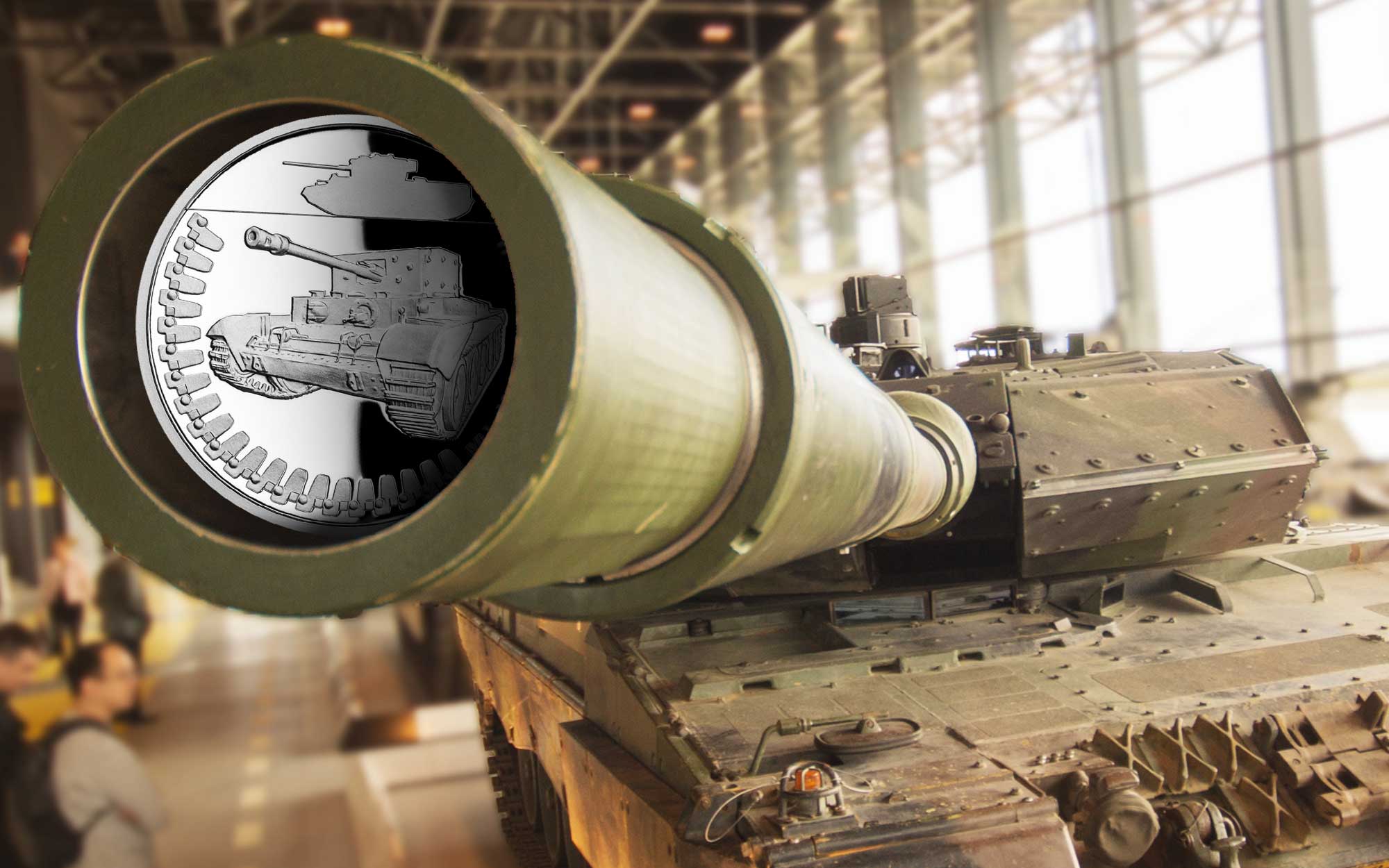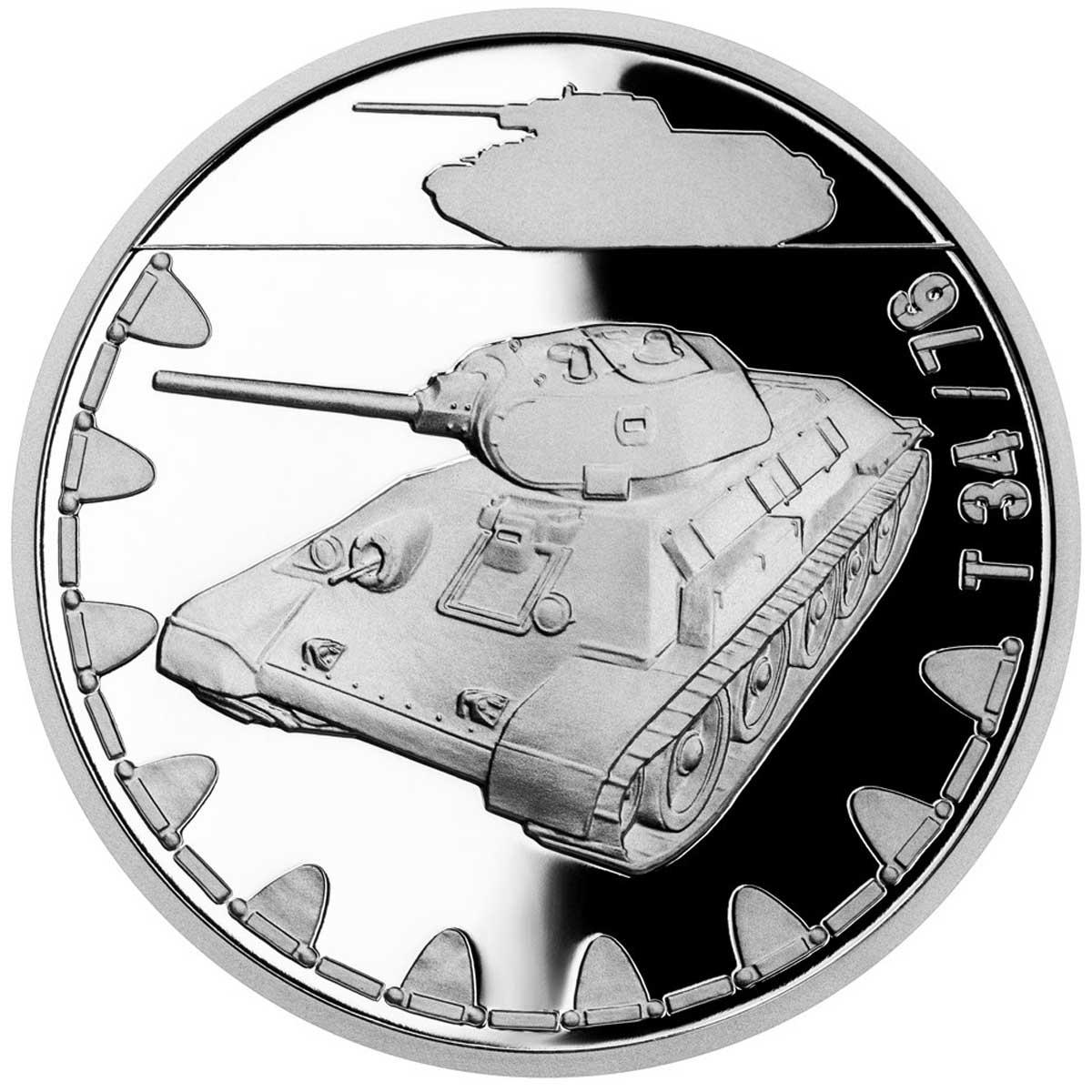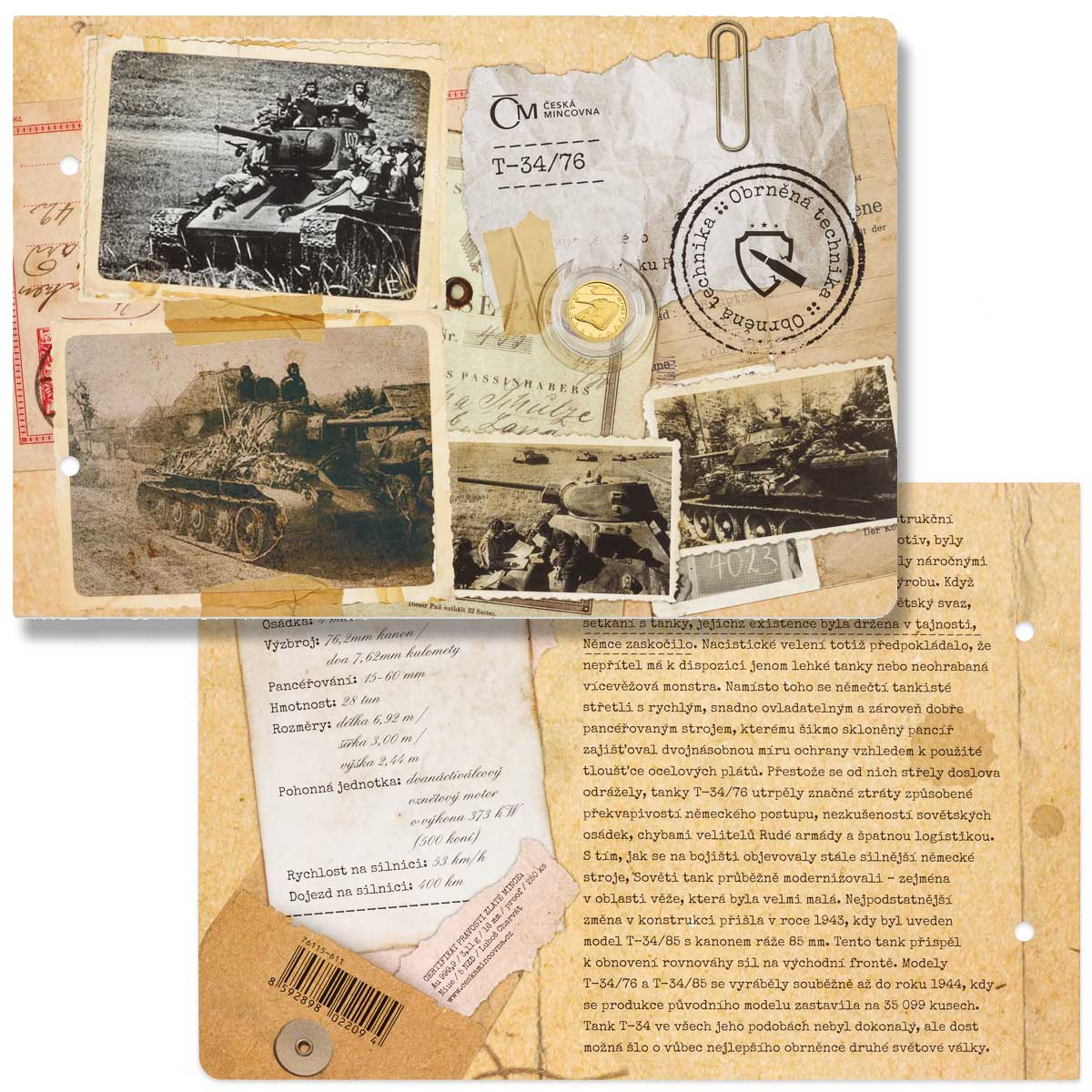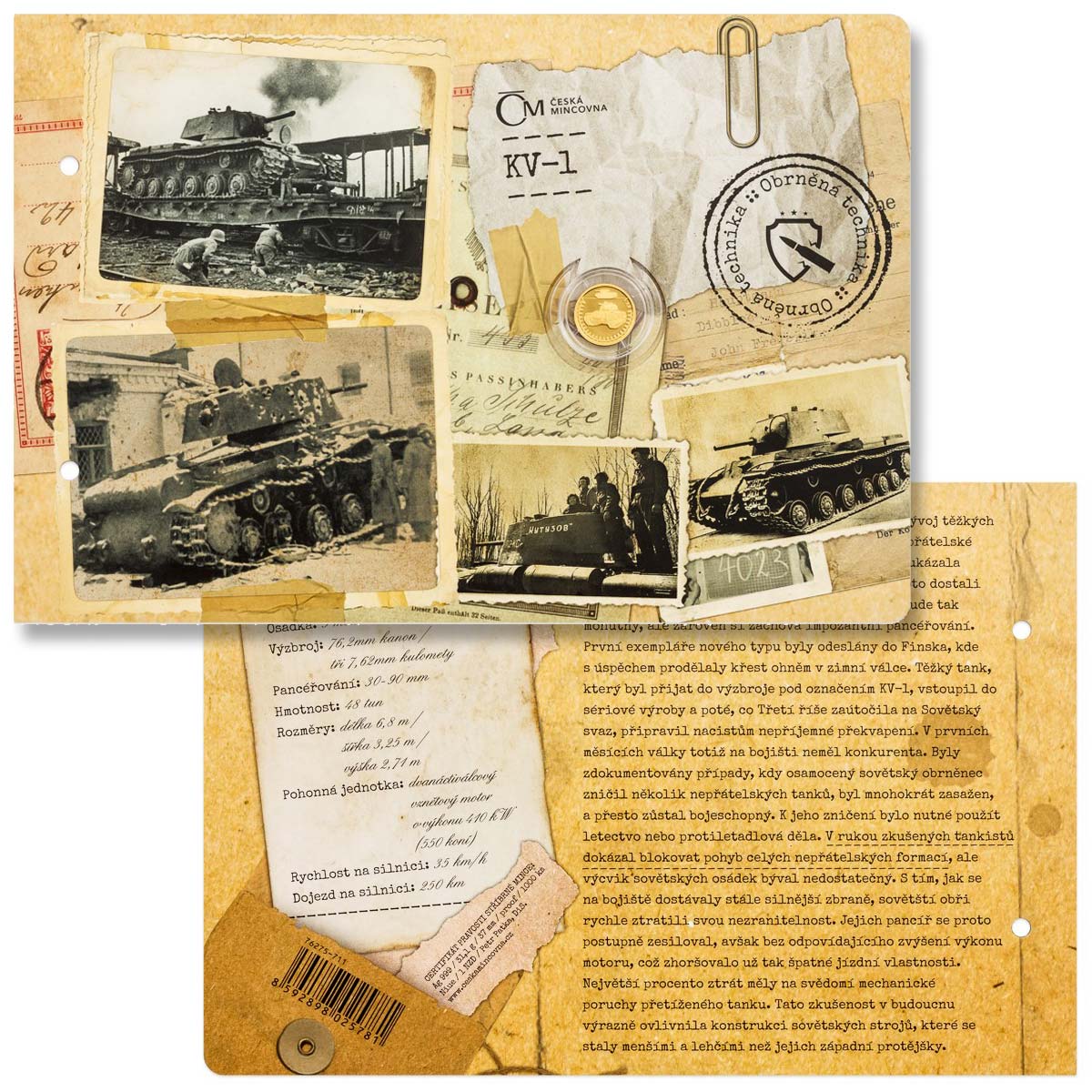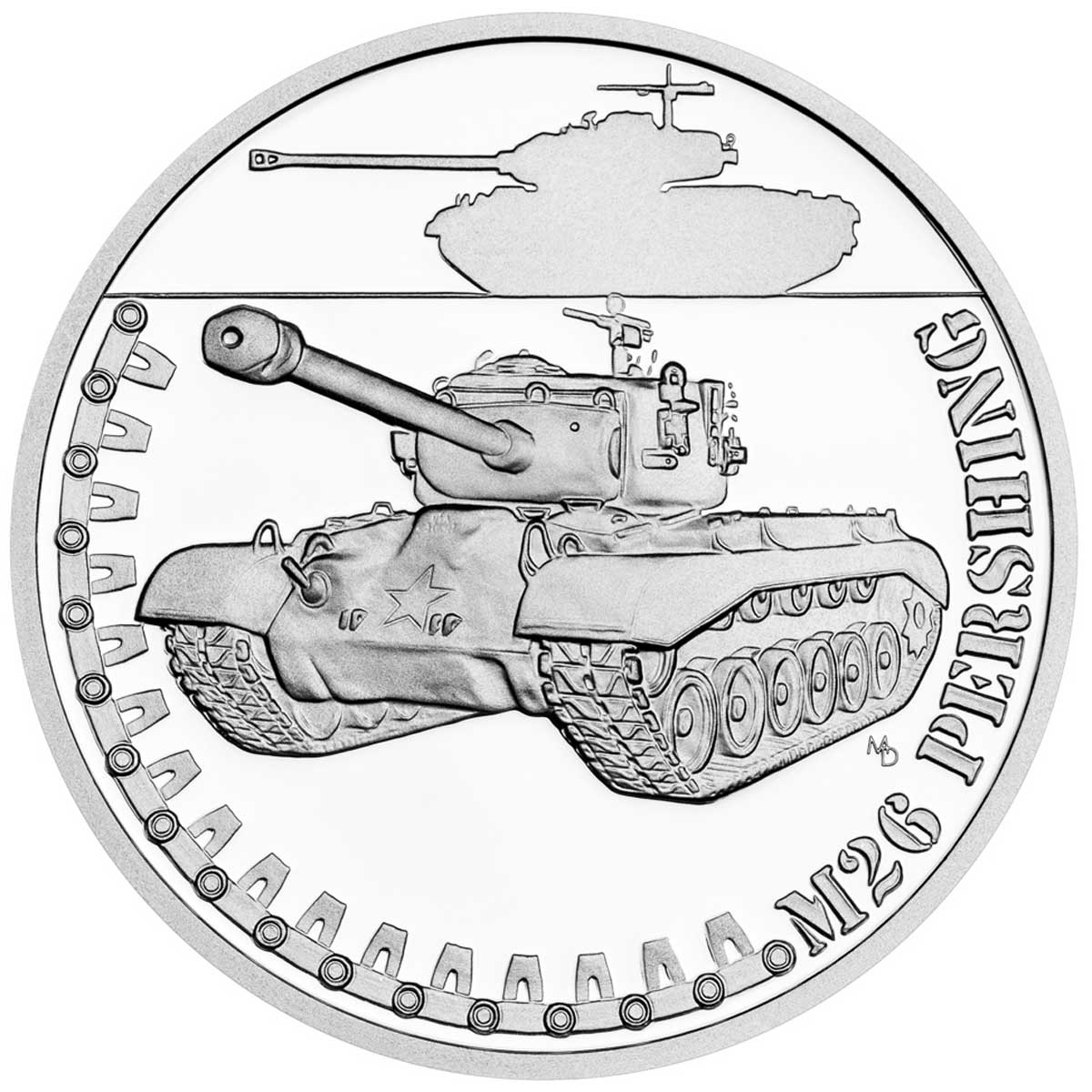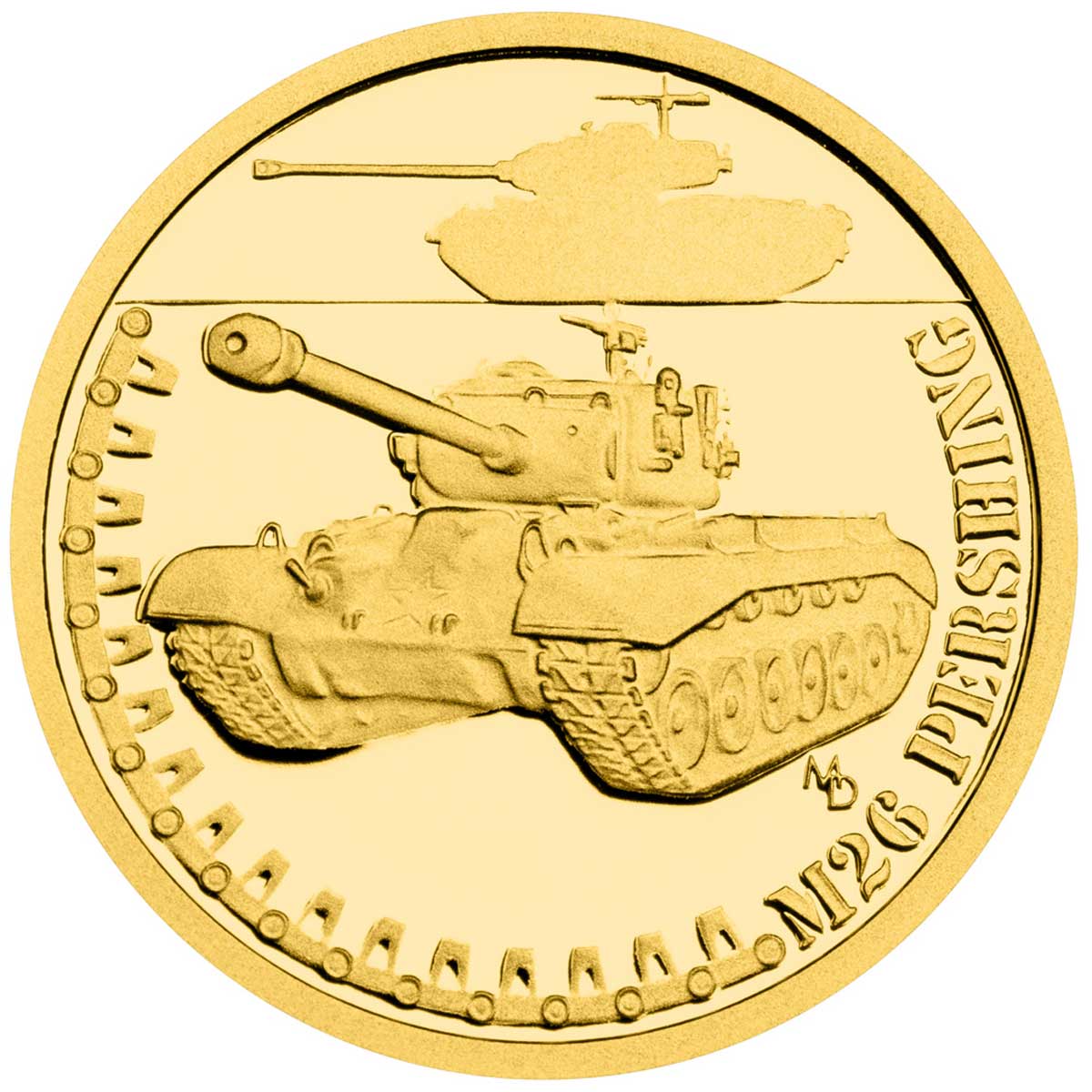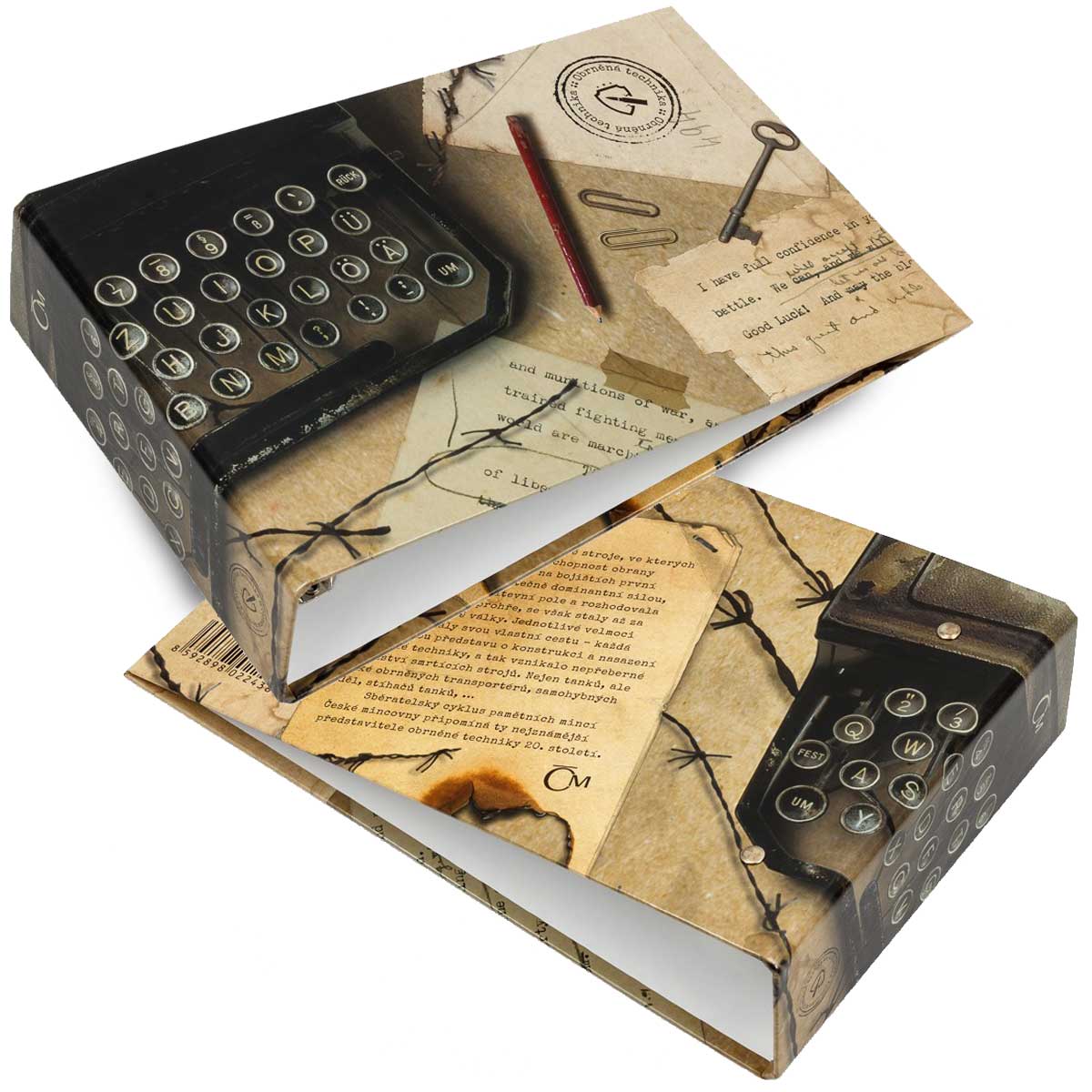ARMOURED VEHICLES (2022-2024) by the Czech Mint
In 2022, the Czech Mint debuted a new four-coin series featuring one of my favourite things – tanks. This isn’t as popular a subject in numismatic circles, with military hardware seemingly less popular than ever, hardly surprising given what’s been going on around the world lately. However, the history of the first half of the 20th century has been a rich source of inspiration for coin issues, and the rise of armoured vehicles a key influence on the direction of warfare in the period.
The series is issued as four coins each year, for three years, so a dozen in total. They are all concentrated on the Second World War, and there is one each year from the UK, the USA, the Soviet Union, and Germany. The 2022 designs by Luboš Charvát, set the style moving forward, which artist Petr Patka, DiS has continued through 2023.
Each depicts a front three-quarter view of the whole tank, with a side silhouette at
the top, and a tank track section acting as a border to the bottom. The tank’s name is also inscribed. The common obverse, with its track patterns, is also very neat and on theme
Each design is available in 1 oz silver (mintage 1,000), or 1/10 oz gold form (250), and both variants come encapsulated, and affixed to a faux catalogue card, packed with period photographs, and information on the tank (Czech language only). The series should wrap up in 2024, which is a shame, as many fine vehicles have not been chosen to appear. Hopefully, the series is popular enough to warrant extending.
TABLE OF CONTENTS
When the Third Reich attacked the Soviet Union in June 1941, its troops clashed with the T-34/76 tanks, whose existence was kept secret. The bewildered Nazi command assumed that the enemy had only light tanks or clumsy multi-towered monsters at their disposal, but instead of that the German panzers encountered fast, easy to handle, and well armoured machines whose sloping armour provided twice the protection of the thickness of the steel plates used. As more and more powerful German machines appeared on the battlefield, the Soviets continually upgraded their medium tanks – especially in the turret area, which was very small.
The most significant change in design came in 1943, when the T-34/85 model was introduced. This tank helped to restore the balance of power on the eastern front. The T-34/76 and T-34/85 models were produced parallel to each other until 1944, when production of the original model ceased at 35,099 units. The T-34 tank in all its forms was not perfect, but it was quite possibly the best armoured tank of the Second World War.
The so-called cruiser tanks, which formed the backbone of British armoured forces in the interwar period, were to operate independently of the infantry and heavy infantry tanks that accompanied them. They were designed to make forays deep into enemy territory and relied almost exclusively on speed. The extraordinary mobility of such tanks went hand in hand with their light weight, and they therefore possessed only thin armour and weak armament. When the cruiser tanks clashed with their much more powerful German counterparts in France and Africa, the British General Staff realized that it had to rethink its existing concept. So the first heavy cruiser tank named the Cromwell was born.
Its armour and firepower rivalled those of medium tanks, yet it remained agile. With its powerful and reliable Rolls-Royce Meteor engine, derived from the famous Merlin aircraft engine that powered such aircraft as the Spitfire fighter, it became the fastest British tank of the war years. Cromwells were first deployed during the Normandy landings in 1944. At the time, British tank regiments were armed primarily with American Shermans, but Cromwells also intervened in the fighting in Europe. They gave British tankers the opportunity to be equal opponents of the Germans.
The heavy Panzerkampfwagen VI Tiger tank had noticeably better armour and more powerful armament than its British and American counterparts. It also became the terror of Soviet tankers, whose machines were unrivalled until then. In fact, the German armored vehicle was equipped with the dreaded 88 millimetre calibre gun, which was based on an anti-aircraft gun and which could penetrate the frontal armour of Soviet heavy tanks even at a distance of half a kilometre. The superiority of the Tigers was so obvious that an expert German crew was able to knock out dozens of enemy armor in a single clash, survive, and repeat their success.
Not surprisingly, the mere mention of the Tigers’ presence on the battlefield terrified the Third Reich’s enemies. However, the German armored monsters were not invincible. Enormous size, structural complexity, enormous fuel consumption, low mobility, vulnerability to rear attack, and the high cost of acquisition all meant that the Tiger used to be an occasional player in combat. The last reliable units took part in the Battle of Berlin at the very end of the war in 1945, but remained a prime example of the qualities of heavy tanks.
The American M4 Sherman tank became the main type used by the Allied armies – it was not only the most important tank of the US Army, but also the best and most widely used type in British service. Under the Lend-Lease Act, it also served the tankers of the Soviet Union. Although this so-called medium tank possessed a balanced combination of mobility, armour protection and firepower, units armed with Shermans suffered heavy losses in the fighting in Tunisia, Normandy and the Ardennes.
The Shermans’ many shortcomings were compensated for by high numbers of deployed vehicles, excellent logistics and air support. Armament was gradually improved, with a special British variant designated Firefly able to successfully match the most powerful enemy tanks. Even with a powerful armament, it took the sacrifice of two Shermans to destroy one Panther or Tiger, but while German industry had been unable to compensate for the loss of equipment on the battlefields since mid-1944, American and British factories had been churning out legions of Shermans and other tanks without ceasing.
The first combat appearance of the Churchill tank was the disastrous raid on Dieppe in 1942, when the entire tank battalion was massacred. It was not surprising – the slow British armoured vehicle was not designed for a poorly planned amphibious operation at all. It was a relic of the experience of the First World War – it was designed as an infantry tank to provide close support to infantrymen on a battlefield littered with trenches and artillery shell craters. Bitter experience prompted the British command to make numerous upgrades, and in the campaigns in Africa and Italy, such a heavily armoured machine performed much better.
In difficult terrain, where it proved sufficiently mobile, it was a significant reinforcement. The opportunity to shine was then given during the Normandy landings. During the invasion, various engineered variants of the tank were used. Some were used to build bridges, others to lay reinforcing mats across soft stretches of beaches, over which other vehicles could drive. The dreaded variants equipped with a flamethrower or a mortar, which was used to destroy fortified positions, proved their worth in combat. Extensive modifications during the war eventually turned the unfashionable tank into a useful fighting machine.
The Nazis got an unpleasant surprise in the form of a heavy tank with the KV-1 designation after the Third Reich attacked the Soviet Union in 1941. In the early months of the war, this bulletproof colossus had no rival on the battlefield. In some cases, a Soviet armoured vehicle destroyed several enemy tanks, was hit many times, and yet remained combat capable. To destroy it, it was necessary to call in dive bombers or use anti-aircraft guns (the feared 88mm Flak). In the hands of experienced tankers, the KV-1 tank could block the movement of entire enemy formations, but the training of Soviet crews was inadequate, which neutralised its advantages.
Moreover, as ever more powerful weapons entered the battlefield, the Soviet giants quickly lost their invulnerability. Their armour was therefore gradually strengthened, but without a corresponding increase in engine power, which worsened their already poor handling characteristics. The largest percentage of losses was due to the mechanical unreliability of the overloaded tank – the gearbox in particular was malfunctioning. This experience greatly influenced the future design of Soviet machines, which became smaller and lighter than their Western counterparts, something which remains the case to this day.
The situation on the Eastern Front developed in favour of the Soviets, who deployed the T-34 machine at the end of 1941. The Nazi General Staff’s response to the serious threat was the Panzerkampfwagen V Panther. Production of the medium tank was given top priority, and the first units left the factory in 1943. At first glance, the German design took inspiration from the Soviet design – the Panther was equipped with sloped armour, a 75/76mm gun, and wide tracks, giving it considerable protection, effective firepower and good mobility.
Testing revealed a number of shortcomings, but there was no time to fix them, as Adolf Hitler decided they be deployed at the Battle of Kursk. The largest tank engagement in history ended in fiasco for the Panther due to frequent failures. Few machines travelled more than a few miles without mechanical problems – the suspension was unreliable, and the engine was to catch fire quite often. The Panther’s successful use was of little tactical significance and, moreover, prematurely revealed the direction of German development, allowing the Soviets to take the necessary countermeasures in time. Despite all this, the continuously improved Panther quickly became the best German tank of World War II. It excelled on the Western Front – in Normandy and the Ardennes it became the terror of Shermans, Cromwells and Churchills, which it dispatched even at a distance of one kilometre. But it could not avert the defeat of the Third Reich. Its numbers were insufficient and its consumption of scarce fuel too high…
The M3 Stuart was the first American-made tank to fight in World War II. Its mass production began in March 1941, and its rugged design reflected the wartime experience of the Europeans in 1939 and 1940. The Stuart had its baptism of fire in North Africa, where the British deployed it against Erwin Rommel’s feared troops. After the Americans themselves became actively involved in the war, the light tank was particularly well suited to the Pacific, where its small size was a significant advantage when fighting in difficult jungle terrain.
The Stuart was not well suited for tank battles – instead, it was a favourite with reconnaissance units. Although tankers often complained about the lack of a powerful gun, high silhouette and sharp edges, they appreciated the considerable level of protection, reliability, speed and agility the Stuart provided. With 13,859 units produced, which also made their way to China, the USSR and Yugoslavia, the M3 tank became the most widely used light armoured vehicle of World War II. Although it was continually upgraded, it was declared obsolete in 1943. Alongside a successor designated the M5, which was the pinnacle of the American light tank development line, it began to be replaced by the M4 Sherman multipurpose medium tank.
When the United States of America involved in the Second World War, the generals favoured highly mobile armoured forces that were capable of carrying out rapid bypasses and penetrating the enemy rear. Their backbone was the M4 Sherman medium tanks. They were reliable, easy to maintain, and factories churned out thousands of units a month. At first, they kept pace with their German counterparts, but soon met stiff resistance in the form of the advanced Tiger and Panther types. Increasing losses of equipment showed that the US Army desperately needed a heavy tank. Therefore, the once-stalled development was restarted, and the first units were produced by the end of 1944. At the time, the Allies had a difficult time in the Ardennes, where the Nazis were mounting a massive counteroffensive, and needed the new armour.
The heavily armed and heavily armoured American M26 Pershing machines arrived on the battlefield in early 1945. Compared to the Tigers, they were lighter and more compact, but just as durable, thanks to ballistic armour shaping. Their 90 mm cannon was one of the most effective anti-tank weapons on the Western Front. The effectiveness of the weapon was further enhanced by a sophisticated sighting system with rapid turret rotation and a gun stabilizer that allowed American tankers to fire without stopping. Despite its qualities, the Pershing did not impact on the fighting of World War II. They came too late. But they set the course for future developments. Because of their light weight, they were reclassified as medium tanks and eventually shone in the Korean War.
2024 PzKpfw IV (08/2024)
To come.
2024 MK VI CRUSADER (10/2024)
To come.
2024 IS-2 (11/2024)
To come.
While the standard gold variants are only a tenth of an ounce in weight, the mint does offer a set of each years gold coins in a tin, and they tip the scales at a half-ounce each. It's a €5k+ item, and there are only 99 sets available each year. The most exclusive way to obtain this series, for sure.
Available at the time of writing for €14.00, this themed ring binder holds the cards that the coins come mounted to. As both the gold and silver coins are mounted to the same size card, the binder is interchangeable between them. It isn't clear how many coins it will hold, but it looks capable of holding all 12 in the series.
SPECIFICATION
| DENOMINATION | COMPOSITION | DIAMETER | FINISH | MINTAGE |
| $1 NZD (Niue) | 31.1 grams of 0.999 silver | 37.0 mm | Proof | 1,000 |
| $25 NZD (Niue) | 15.55 grams of 0.9999 gold (x4) | 28.0 mm | Proof | 99 sets |
| $5 NZD (Niue) | 3.11 grams of 0.9999 gold | 16.0 mm | Proof | 250 |


